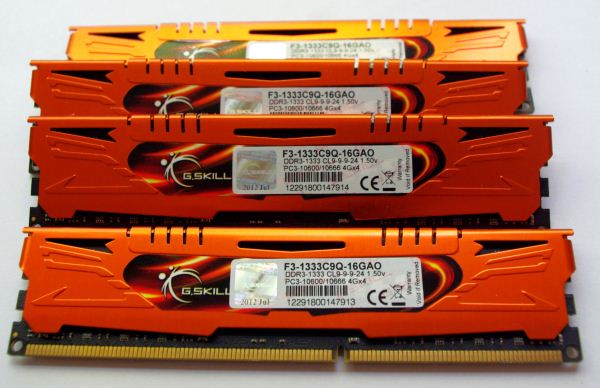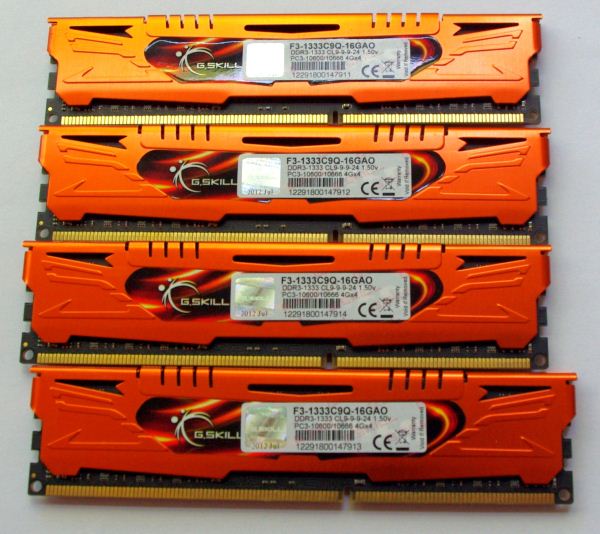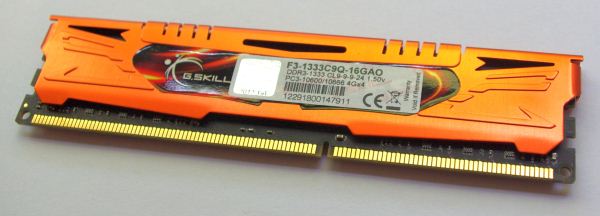Memory Performance: 16GB DDR3-1333 to DDR3-2400 on Ivy Bridge IGP with G.Skill
by Ian Cutress on October 18, 2012 12:00 PM EST- Posted in
- Memory
- G.Skill
- Ivy Bridge
- DDR3
At the lowest end of our testing, we have a 16GB DDR3-1333 9-9-9 kit on hand. When DDR3 was first released, the main speed available was DDR3-800, but enough time has passed that this has phased out and now 1333 MHz is the new ‘minimum’. With the prices of memory as they are, this kit from G.Skill currently retails for $75, meaning that a massive amount of memory is available for all at a reasonable level. To put this into contrast, I remember spending ~$240 on a 2x2 GB Kit of DDR2-800 5-5-5 about 5-6 years ago – we can now get four times the capacity for less than a third of the price.
DDR3-1333 sits at the bottom end, but within months we can imagine DDR3-1600 taking that spot – as we will see with the next kit, for $5 more we get a faster product.
Visual Inspection
Our first kit features G.Skill’s Ares branding – the Ares kits that G.Skill sell are essentially meant to be the lower profile but colored heatsinks. These heatsinks in all honesty may not be entirely necessary for cooling, but they are firmly bonded to the memory modules and removing them would be a large task and more than likely damage the module. I have seen horror stories of chips being removed along with the heatsink, making the memory unusable. As a result we cannot directly observe which ICs are being used in our kits for this review. A quick word in the ear of G.Skill and they will not tell us the information, under the guise that it is classified and if the competition wants to know what G.Skill are using, they will have to buy a kit and break it themselves. Given how small the margins are in memory sales (as well as potential market stagnation after the credit crisis), I’m not surprised with the level of secrecy.
Anyway, back to the kit:
The standard packaging at G.Skill is a rather efficient plastic container holding each of the modules. The packaging is easy enough to open, though I also found it fairly brittle, meaning small shards could break off and be easily lodged in feet. Inside the box itself is a piece of card to advertise the kit and protect the modules from each other. We also get a small G.Skill sticker for the computer case.
JEDEC + XMP Settings
| G.Skill | |||||
| Kit Speed | 1333 | 1600 | 1866 | 2133 | 2400 |
| Subtimings | 9-9-9-24 2T | 9-9-9-24 2T | 9-10-9-28 2T | 9-11-10-28 2T | 10-12-12-31 2T |
| Price | $75 | $80 | $95 | $130 | $145 |
| XMP | No | Yes | Yes | Yes | Yes |
| Size | 4 x 4 GB | 4 x 4 GB | 4 x 4 GB | 4 x 4 GB | 4 x 4 GB |
|
|
|||||
| MHz | 1333 | 1600 | 1867 | 2134 | 2401 |
| Voltage | 1.500 | 1.500 | 1.500 | 1.650 | 1.650 |
| tCL | 9 | 9 | 9 | 9 | 10 |
| tRCD | 9 | 9 | 10 | 11 | 12 |
| tRP | 9 | 9 | 9 | 10 | 12 |
| tRAS | 24 | 24 | 28 | 28 | 31 |
| tRC | 33 | 33 | 37 | 38 | 43 |
| tWR | 10 | 12 | 14 | 16 | 16 |
| tRRD | 4 | 5 | 5 | 6 | 7/6 |
| tRFC | 107 | 128 | 150 | 171 | 313 |
| tWTR | 5 | 6 | 8/7 | 9/8 | 10/9 |
| tRTP | 5 | 6 | 8/7 | 9/8 | 10/9 |
| tFAW | 20 | 24 | 24 | 25 | 26 |
| tCWL | - | 7 | 7 | 7 | 7 |
| CR | - | 2 | 2 | 2 | 2 |






















114 Comments
View All Comments
crackedwiseman - Thursday, October 18, 2012 - link
OK, just one question: why in the hell are the IGP memory tests done on an i7? The results would be much more meaningful if the tests were on an AMD A10 or similar - it has a beefier IGP, and thus would be more bandwidth-bound.creed3020 - Thursday, October 18, 2012 - link
100% Agree. Doing these tests against a Trinity APU would have been much more interesting from a iGPU point of view. It it well known that AMD APUs benefit from increased memory bandwidth, AT has yet to test Trinity for this yet they did it for Llano.silverblue - Thursday, October 18, 2012 - link
It makes sense to test; HD 4000 is far superior to HD 3000 and it is worth knowing if that extra power is bandwidth limited. Generally, it is a little, though nowhere near as much as AMD's equivalents are.JonnyDough - Monday, October 22, 2012 - link
Not to mention, it's surprising to me that AMD wasn't mentioned as a company trying to match memory to motherboard. AMD started making their own memory modules, an interesting fact I think.SeanJ76 - Saturday, June 21, 2014 - link
AMD is a decade behind Intel, in processor technology and instructions, it really doesn't matter what AMD attempts to do....SeanJ76 - Saturday, June 21, 2014 - link
No one gives a shit about APU you moron......these are desktop tests!hp79 - Thursday, October 18, 2012 - link
Maybe because more people use intel? I agree that it would have stood out more if it was AMD's IGP, but doing the test on intel IGP is also okay and gives an idea of what to expect. I think the article is fine. Besides, do people really play games with IGP? If I am playing demanding games, I want the frame rates to be minimum 60 fps. That's why I use a dedicated graphics card. This might change when AMD's IGP gets even more powerful, but for now I think it's still not there yet.zcat - Thursday, October 18, 2012 - link
> Besides, do people really play games with IGP?Some of us do. My miniitx i7 is primarily for work & everyday use, but its HD4000 is fast enough for Portal 2 and Diablo 3 to be very playable @ 1920x1080p with AA off.
However, I know the limits of IGP, and intend on upgrading to an overclocked GeForce GTX 650 Ti very soon in order to play some more demanding games this winter.
sking.tech - Monday, October 22, 2012 - link
you may want to reconsider your choice of video "upgrade"nvidia's 2nd number is more significant than the first as far as overall gaming graphics power goes... You'd do better going for a 560 TI than a 650 for approx the same cost
Dirk Broer - Wednesday, July 24, 2013 - link
You should first look at what chip actually powers the card -and it's capabilities- before staring yourself blind on the last two digits. Besides that, a GTX 560 Ti is more expensive than a GTX 650.